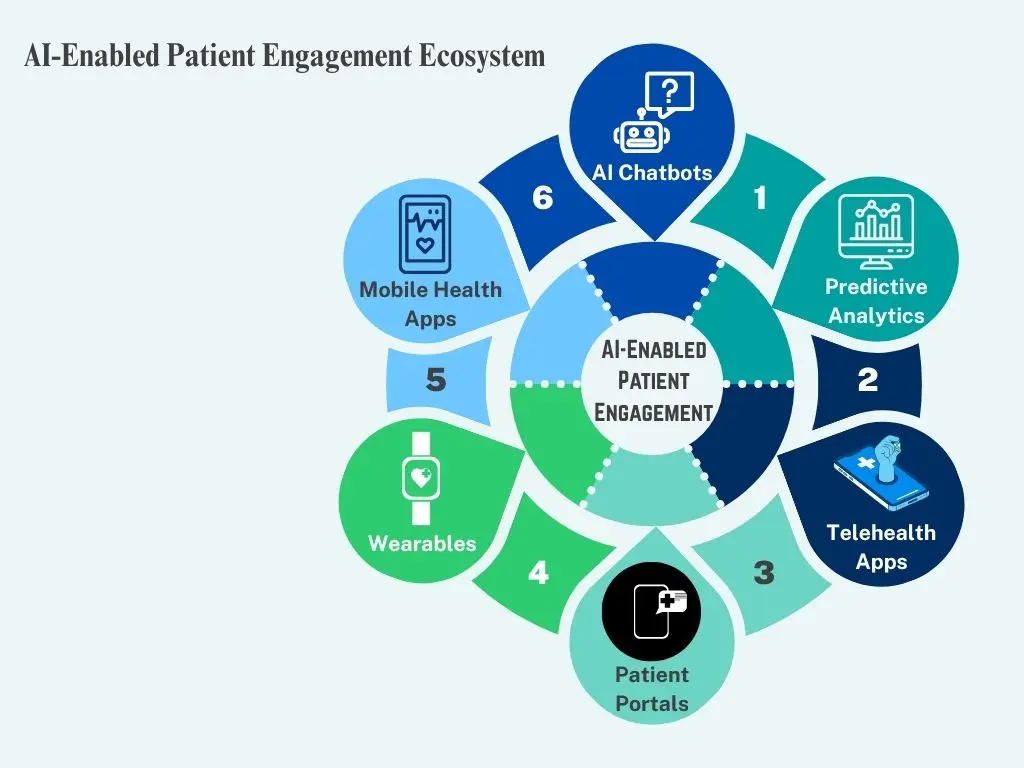 By Jobin George November 18, 2025
min read
By Jobin George November 18, 2025
min readHow to Improve Patient Engagement in Healthcare?
Executive Summary
Patient engagement in healthcare has evolved from simple communication to a connected, personalized care experience. As digital transformation accelerates, strong engagement is now a core driver of better outcomes, operational efficiency, and long-term patient trust.
60-Second Action Plan
- View engagement as a blend of better outcomes + patient loyalty
- Use digital touchpoints to simplify communication and access
- Keep systems connected so staff avoid workflow friction
- Track essential engagement signals – appointments, messages, adherence
For teams exploring technology options, Fortunesoft – a healthcare technology leader – offers Patient Engagement Software Solutions that unify communication, personalize interactions, and strengthen engagement across the care continuum.
Table of contents
- What Is Patient Engagement in Healthcare?
- Importance of Patient Engagement in Healthcare
- Benefits of Patient Engagement in Healthcare
- The Shift Toward Digital Patient Engagement
- Common Barriers to Patient Engagement
- Improving Patient Engagement: 7 Proven Strategies That Work
- Measuring the Impact of Patient Engagement
- The Role of AI and Predictive Analytics in Modern Engagement
- Case Studies & Evidence
- How Healthcare Organizations Can Get Started

What Is Patient Engagement in Healthcare?
Patient engagement in healthcare refers to the process of empowering patients to actively participate in their care journey, making informed decisions, managing treatments, and collaborating with providers.
Engaged patients are more likely to adhere to care plans, report better satisfaction, and demonstrate lower readmission rates. According to the U.S. Department of Health and Human Services (HHS), organizations that foster patient involvement experience measurable improvements in both clinical and operational outcomes.
Importance of Patient Engagement in Healthcare
The importance of patient engagement in healthcare extends beyond communication; it’s a shared responsibility. When patients understand their health data, treatment options, and recovery steps, they’re more compliant and proactive.
For C-suite leaders, engagement directly impacts value-based care performance, population health management, and HCAHPS scores. Active patient participation is proving essential for better outcomes and efficient care delivery. Studies by WHO show that meaningful patient engagement could reduce the burden of harm by up to 15%, saving countless lives and billions in healthcare costs.
Benefits of Patient Engagement in Healthcare
Improving patient engagement yields both qualitative and quantitative benefits across all stakeholders:
- For Patients: Better self-management, reduced anxiety, and enhanced trust in providers.
- For Providers: Optimized workflows, fewer no-shows, and improved care coordination.
- For Payers: Lower costs through fewer hospitalizations and better preventive care.
With about 70% of hospitals investing in digital Patient engagement tools to enhance patient engagement in healthcare, the importance of engagement in achieving value-based care has become undeniable.
The Shift Toward Digital Patient Engagement
Digital innovation is transforming the ways healthcare engages with patients. Healthcare mobile apps, patient portals, telehealth, wearables, and personalized dashboards are turning care into a continuous, two-way dialogue.
How Tech Adoption Is Reshaping Engagement Frameworks
Smart technologies like secure messaging, remote patient monitoring, and integrated EHR systems have made engagement scalable, and data driven. Modern frameworks prioritize real-time updates, transparency, and personalization, key for today’s digital-native patients seeking convenience and control.
Common Barriers to Patient Engagement
Despite the growing adoption of digital platforms, several barriers continue to limit the success of patient engagement in healthcare:
- Low health literacy: Many patients struggle to interpret medical information, reducing their ability to actively participate in decisions about their care.
- Data silos: Fragmented EHR systems and disconnected data streams create gaps in communication, slowing progress on how to improve patient engagement in healthcare.
- Workflow inefficiencies: Administrative overload and poor interoperability make it harder for providers to sustain meaningful engagement.
- Limited access and equity gaps: Rural, underserved, and aging populations often face digital and financial barriers that restrict participation.
- Cultural and communication barriers: Language differences, varying health beliefs, and low trust further hinder engagement efforts.
According to research, literacy gaps and fragmented data systems remain the two biggest obstacles to improving patient engagement in healthcare, emphasizing the need for streamlined, inclusive, and data-driven engagement models.
Improving Patient Engagement: 7 Proven Strategies That Work

- Adopt an omnichannel communication model – Offer seamless engagement across apps, SMS, email, and patient portals.
- Personalize care journeys – Use data analytics to tailor content, reminders, and care plans.
- Enhance health literacy – Provide plain-language summaries, visuals, and culturally relevant materials.
- Integrate telehealth for accessibility – Enable on-demand consultations and chronic care management.
- Gamify participation – Use progress tracking and reward systems to sustain engagement.
- Leverage predictive analytics – This helps in identifying patients at risk of disengaging and acting early based on behavioral insights.
- Close the feedback loop – Encourage real-time reviews and use them for service optimization.
Each of these strategies connects directly to the primary goal, how of improving patient engagement in healthcare by uniting personalization, education, and technology.
Measuring the Impact of Patient Engagement
Key metrics for evaluating success include:
- Patient adherence rates
- Readmission and retention data
- Patient-Reported Outcome Measures (PROMs)
- Net Promoter Score (NPS)
Tracking these KPIs enables leadership to quantify ROI and refine engagement models continuously. Advanced analytics dashboards make these insights actionable across departments.
The Role of AI and Predictive Analytics in Modern Engagement
Artificial Intelligence (AI) and predictive modeling are transforming engagement from reactive to proactive.
Patient Engagement Tools in Healthcare
Modern tools – ranging from patient apps and engagement dashboards to AI chatbots, simplify access, automated reminders, and personalize touchpoints.
Agentic AI Improving Patient Engagement Examples
Agentic AI is redefining how to improve patient engagement in healthcare by turning static digital tools into adaptive, decision-making systems. Rather than passively waiting for patient responses, these AI agents proactively engage patients with personalized interactions that boost adherence, satisfaction, and continuity of care.
Example 1 – Predictive Outreach:
AI models detect early signs of disengagement—missed refills, low portal activity, or delayed follow-ups—and trigger automated, context-aware nudges. Health systems using such workflows report measurable gains in adherence and a reduction in missed appointments.
Example 2 – Real-time Support:
Conversational agents embedded in patient portals guide users through care plans, billing, or symptom triage 24/7, improving response times and reducing administrative load.
Example 3 – Personalized Care Pathways:
Agentic AI synthesizes data from EHRs, wearables, and surveys to adjust communication frequency, content, and tone based on each patient’s engagement score, delivering the right information at the right moment.
According to Gartner, global AI software spending in healthcare and life sciences is expected to grow 16.4% in 2024, reaching $11.6 billion and projected to hit $18.9 billion by 2027. This sustained investment underscores the confidence healthcare leaders place in AI’s ability to enhance patient engagement, optimize clinical outcomes, and drive measurable operational value.
Case Studies & Evidence of Patient Engagement
Real-world examples demonstrate how improving patient engagement in healthcare leads to measurable outcomes across multiple stakeholders.
System-Level Patient Engagement: U.S. Health System
- Intervention: Embedded patient and family advisers within quality and safety committees.
- Outcome: Significant reduction in medication errors and improved clinical communication.
- Impact: Promoted patient and family participation in care decision-making.
Integrated Care Models
- Intervention: Alignment of fragmented care domains across hospitals, home health, and community organizations.
- Outcome: Enhanced patient engagement, smoother care transitions, and reduced readmission risks.
- Impact: Encouraged collaboration among clinicians, patients, and care teams.
Diagnostic Engagement
- Intervention: Patients educated on test follow-ups and encouraged to report diagnostic errors.
- Outcome: Greater patient participation in diagnostic safety.
- Impact: Demonstrated potential to reduce errors while improving trust and adherence.
Global Patient Engagement Initiatives
- United Kingdom: Online mental health community increased patient interaction and responsiveness.
- United Arab Emirates: AI-supported genetic screening program improved early detection and patient compliance.
- World Health Organization: Postnatal engagement checklists reduced maternal complications and extended reach into local communities.
Fortunesoft Solutions to Elevate Patient Engagement in Healthcare
Driving stronger patient engagement in healthcare starts with a clear strategy and the right technology foundation. Fortunesoft helps healthcare organizations turn engagement goals into scalable, measurable, and patient-first digital experiences. Our team works closely with clinical, operational, and IT stakeholders to build systems that improve satisfaction, care continuity, and outcomes.
To accelerate your engagement journey, we guide you through:
- Assessing your current engagement maturity across workflows, data flow, patient literacy, and digital readiness
- Prioritizing interoperability and security to ensure seamless data exchange across EHRs, portals, and patient-facing apps
- Building accessible, intuitive patient experiences across mobile, web, and remote care channels
- Training staff and improving adoption through streamlined workflows and clear operational alignment
- Partnering for long-term scalability, not just tool deployment
Healthcare leaders ready to transform patient interactions can explore our Patient Engagement Software Solutions to shift from episodic communication to a continuous, proactive engagement model.
Conclusion
Improving patient engagement in healthcare is about aligning technology, empathy, and measurable outcomes. With the right digital frameworks, leadership vision, and analytics, healthcare organizations can deliver care that is not just efficient, but truly patient-centered.
FAQs
1. Why is patient engagement in healthcare important?
It strengthens collaboration, boosts outcomes, and supports value-based care models.
2. What are key benefits of patient engagement?
Improved satisfaction, lower costs, and enhanced trust between patients and providers.
3. How does AI improve patient engagement?
AI personalizes interactions, predicts disengagement, and automates follow-ups for higher adherence.
4. How can healthcare leaders start improving patient engagement?
By integrating Patient Engagement Software Solutions, fostering literacy, and leveraging predictive insights.
5. What are examples of patient engagement tools?
Patient engagement tools in healthcare include:
- Patient portals for accessing health data and test results.
- Telehealth platforms for remote consultations.
- Mobile health apps for medication reminders and progress tracking.
- Wearables that collect real-time health metrics.
- AI chatbots for 24/7 assistance and care coordination. These tools enable continuous communication and personalization, which are critical for improving patient engagement.
6. What are examples of patient engagement tools?
Patient portals, telehealth apps, wearables, and AI-driven dashboards that improve communication and access to care.
7. How can AI improve patient engagement?
By predicting patient needs, personalizing care plans, and automating reminders to enhance satisfaction and adherence.
8. How does patient engagement improve healthcare outcomes?
It boosts adherence, reduces readmissions, and drives measurable improvements in clinical and operational performance.
9. What is the difference between patient engagement and activation?
Engagement is how organizations support participation; activation is the patient’s readiness to act – together; they drive better outcomes.
Sources
- “Top Strategic Technology Trends 2024” (Report ID: 5545095). https://www.gartner.com/en/documents/5545095#:~:text=Summary,activities%20for%202024%20and%20beyond
- World Health Organization (WHO). Patient Safety – Fact Sheet. https://www.who.int/news-room/fact-sheets/detail/patient-safety
- Gitnux. Digital Health Industry Statistics – Digital Transformation in the Health Industry. https://gitnux.org/digital-transformation-in-the-health-industry-statistics/
Author Bio


 Facebook
Facebook Whatsapp
Whatsapp LinkedIn
LinkedIn Pinterest
Pinterest













 Start Chat
Start Chat